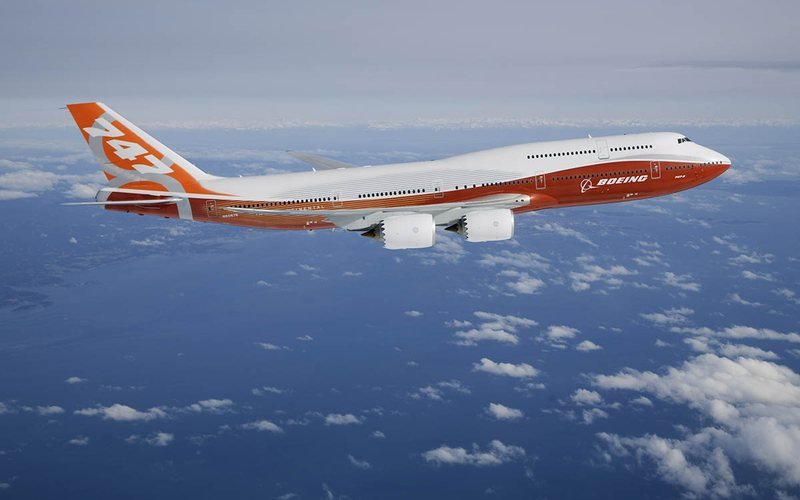[aviation news]
Comparative reveals that the heaven giant surprises in efficiency by passenger against cars and trains at long distances
Did you know that a Boeing 747-8, in a cruise flight, can be more economical per passenger than a popular car running on the road? The giant quadimotor consumes, on average, 11.74 liters of fuel per kilometer, but when the spending is distributed by 410 passengers on board, efficiency reaches 24.7 km/l by occupant – performance that surpasses many cars on long distance trips. What’s more, the plane also rivals rail transport, showing that in modern aviation size does not always mean waste.
The Boeing 747-8 consumes, on average, the equivalent 11.74 liters of fuel per kilometer or travels 0.06 km with one liters of kerosene on a cruise flight, considering a setting with 410 passengers and range of 14,320 kilometers. On a typical 10 -hour flight, consumption can reach approximately 150 thousand liters of fuel. Total that considers the weight of the plane, passengers transported, crew and load.
Although the absolute index seems high compared to land vehicles, efficiency improves significantly when analyzed by passenger: 24.7 km/l per occupant. Already a popular car 1.6 consumes, on average, 45 liters of fuel to run 500 km, or 22.5 liters per person to travel only the average distance between São Paulo and Rio de Janeiro (considering a realistic path). Considering a distance of 10,000 km, the value is almost 18 times higher than that registered by passenger 747-8 on a cruise flight.
The GE P42DC locomotive of the Genesis series, the most popular in rail passenger transport in the United States, has a consumption per kilometer of approximately 5.87 liters. In terms of passenger efficiency, P42DC carrying 400 passengers has an efficiency of about 68 km/l per passenger.
On the other hand, the Siemens ACS-64 electric locomotive, used by AMTRAK in the northeastern corridor of the United States, consumes an average of 12 kWh per kilometer in operation with a complete train of 18 wagons and total capacity for about 1,000 passengers. Considering a hypothetical railway of 10,000 kilometers and an equivalent base of 400 passengers, the ACS-64 consumes about 1,080 mJ/passenger, while Boeing 747-8 reaches about 13,150 mJ per passenger at the same distance-a difference of over 12 times in favor of the electric train.
Of course, the operation profile-such as speed, necessary infrastructure, travel time and effective environmental impact-varies between modes, but in purely energy consumption per passenger and distance, 747-8 has an amazing efficiency for a large quadrimotor.
Consumption in pounds per hour
In aviation fuel consumption is not measured in liters, but in pounds per hour. In a cruise flight, from the second hour, the 747-8 consumes about 11 thousand pounds of fuel per hour-the equivalent of approximately 4 liters per second.
Several variables affect this consumption:
- Carried
- Cruise altitude
- Weather conditions
- Predominant winds
- Air traffic
A study by the University of Technology of Poznań (Poland) pointed out that a 40 knot tail wind can reduce consumption by up to 14%compared to contrary winds of equal intensity.
The evolution of efficiency in the Boeing 747 family
Over more than fifty years of operation, line 747 has evolved considerably in terms of fuel consumption efficiency. The data below show cruise flight performance:
- 747-100: 0.14 km/l;
- 747-200B: 0,23 km / l;
- 747-300 and 747-400: around 0.22 km/l;
- 747-8f (freighter): about 0.034 km/l.
Despite the relative efficiency by passenger, the Boeing 747-8 faces economic challenges in the current scenario. With only three active operators in the passenger version, the 747-8 sees the demand decline: according to Cirium data, just over 10,000 flights are scheduled in 2025-less than 12,000 registered in the previous year. There are currently 31 units of 747-8 in the passenger version in operation, as well as six BBJ747-8 and 89 other 747-8F freighters.
Although it marks an important chapter in the history of aviation, the 747-8 is pressured by more modern and efficient bimothors that offer even more attractive consumption.
*Collaborated Edmundo Ubiratan and Grace McPherson
!function(f,b,e,v,n,t,s)
{if(f.fbq)return;n=f.fbq=function(){n.callMethod?
n.callMethod.apply(n,arguments):n.queue.push(arguments)};
if(!f._fbq)f._fbq=n;n.push=n;n.loaded=!0;n.version=’2.0′;
n.queue=[];t=b.createElement(e);t.async=!0;
t.src=v;s=b.getElementsByTagName(e)[0];
s.parentNode.insertBefore(t,s)}(window,document,’script’,
‘
fbq(‘init’, ‘1626712270970227’);
fbq(‘track’, ‘PageView’);
Share this content:


